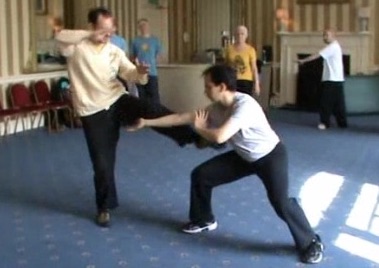PRACTICING AT ABOUT 30% TO PREVENT OVER-TRAINING

Sifu Tim and Frederick Chu at a Baguazhang course
Question
The recommendation to train at 30% of one's potential is excellent advice and has definitely cut back on symptoms of over-training, to say nothing of bringing greater mental clarity after the practice.
— Fredrick, USA
Answer
It is actually amazing, or ridiculous, that while most dedicated students want to get the best from their practice, we tell our students not to train at their potential.
We have to do this because we have become so cost-effective that over-training is an important issue in our school. Over-training is practicing the techniques and skills of any exercise or exercises correctly, but the energy developed is too powerful for our physical body to bear.
Wrong training is not an issue in our school. Wrong training is practicing an exercise or exercises wrongly which results in harmful effects. In fact, we tell our students not to worry even when they realize they have made a mistake in their training because their subsequent chi flow will not only erase whatever harm they may have caused due to the mistake, but also the chi flow will give them a big bonus of benefit.
We may appear boastful but it is true that even when our students made some mistakes in their training due to forgetfulness or carelessness, and had chosen a worst technique to practice, they would have more benefit than other students who had chosen a best technique. This is because our students practice genuine chi kung whereas other students, even when their techniques are genuine, practice gentle physical exercise.
Mistakes here refer to mistakes due to carelessness or forgetfulness. It is not mistakes due to someone who purposely go against instructions. If a student continues to intellectualize although he has been instructed not to worry and not to intellectualize, then he is aiming for trouble. If he cannot stop intellectualizing, our chi kung is not for him. But if he intellectualizes due to carelessness or forgetfulness, it is alright.
On the other hand, purposely intellectualizing or tensing muscles, can be used as negative action to prevent over-training. The practitioner should have some chi flow at the end of the training session to clear the harm due to intellectualizing or tensing muscles.
An excellent way to prevent over-training is to perform far less than potential, like at 30%. An excellent way to do this is not to enter too deeply into a chi kung state of mind.
A practical approach is as follows. Take the normal chi kung state of mind as 100%. Practice any chi kung or kungfu exercise at half the depth of this potential chi kung state of mind, i.e. at 50%. In the next training session, practice at half of this depth, i.e. at 25%. This will give a good indication of how to practice at 30% or at whatever level of depth is suitable.
Please note that 100% chi kung state of mind of one person is different from that of another person. In other words, different people have different depth in their chi kung state of mind.
Another important point to note is that as a student in our school progresses, his benefits will also increase although he continues to practice at the same depth of his chi kung state of mind, like at 30%. In other words, a student practicing his chi kung or kungfu at 30% of his potential a year later, may have 3 times the benefits he had when he first started learning at 100%. If a year ago when he first started, he practiced at 30%, his benefits now when he still practices at 30% will be about 10 times more.
The above is taken from Question 2 January 2017 Part 2 of the Selection of Questions and Answers.
LINKS
Courses and Classes
